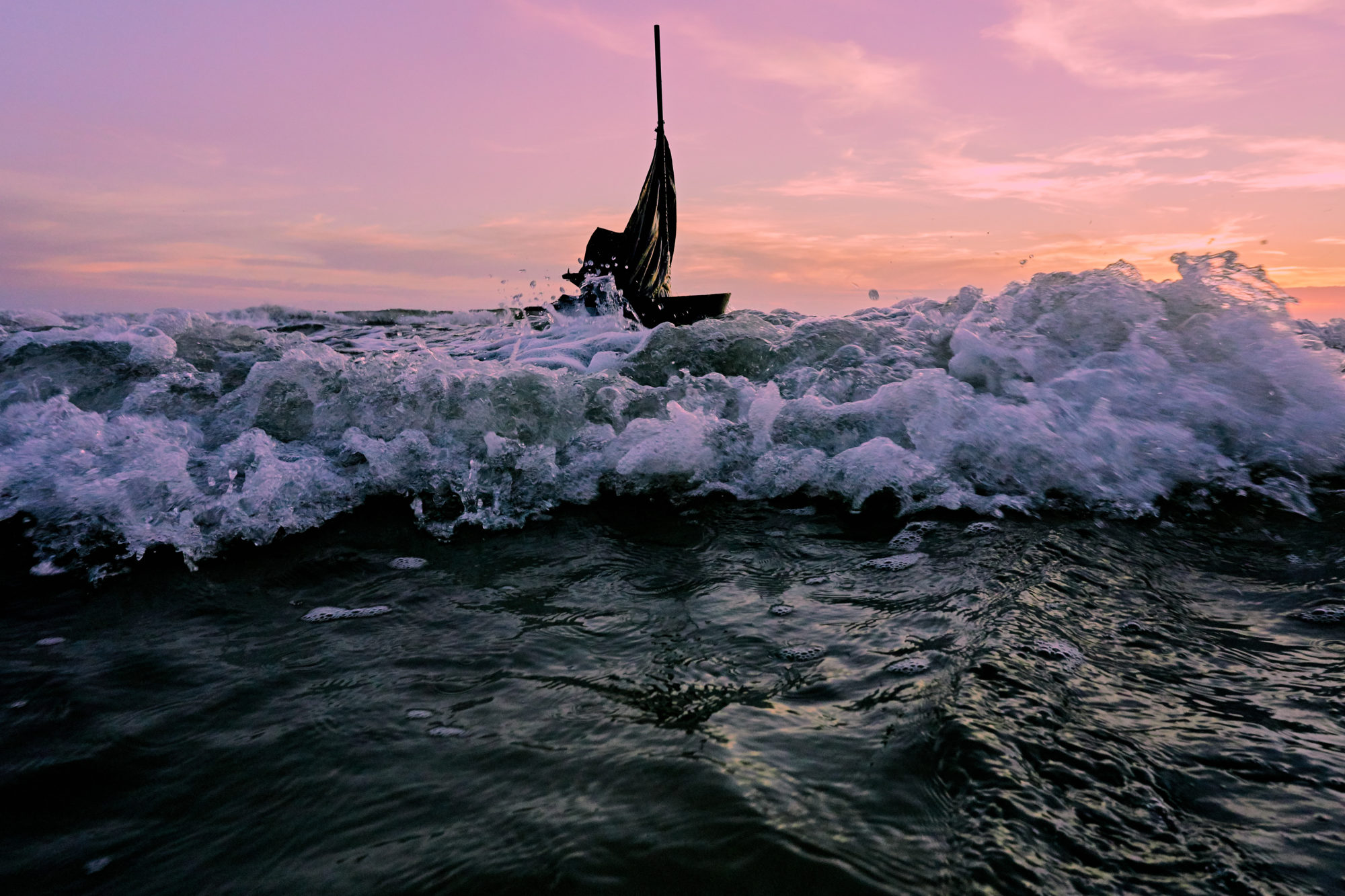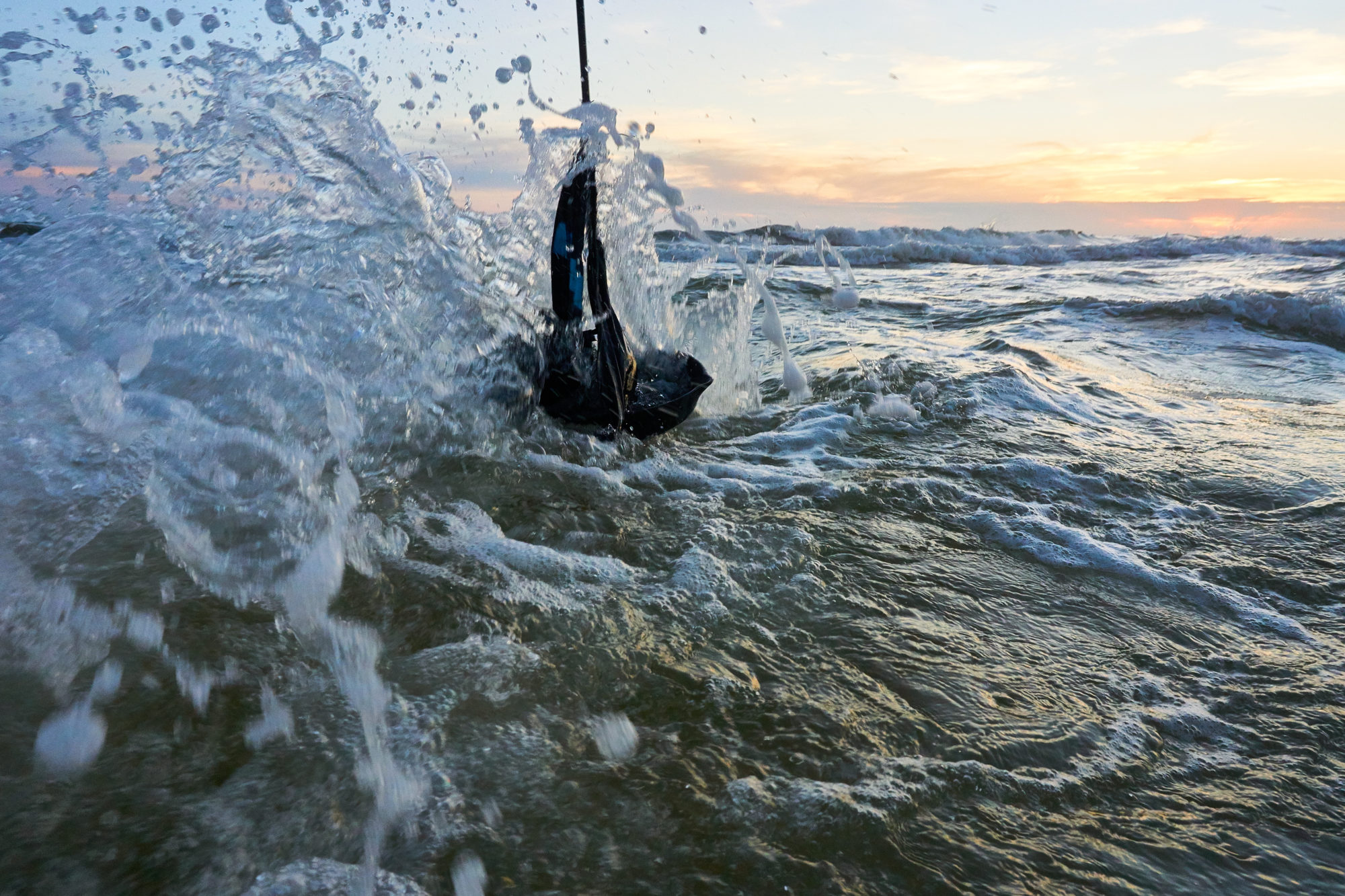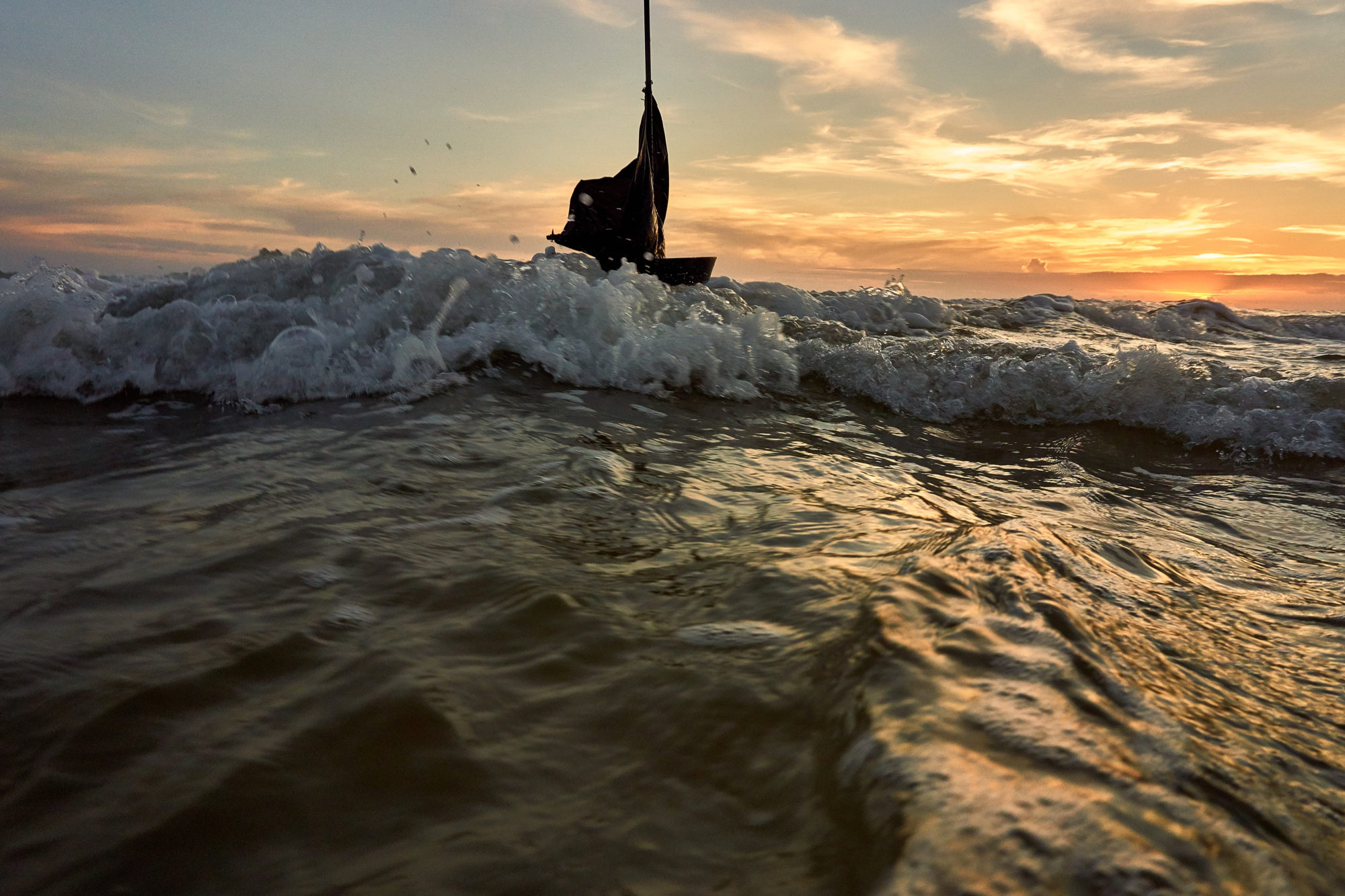Cast Iron

Michi Meko, “Purple Haze,” 2016 [courtesy of the artist]
Share:
Last year I almost drowned.
The event was metaphorical as well as physical—a collision of life and art in mutual imitation. It was like nature wanted to test the thoughts behind my studio practice: systems of theories and beliefs built around the idea of Black Buoyancy.
My work considers resilience, resilience that lives within the experience of Blackness and makes every Black American in the south a hero, because he stays afloat like a buoy at sea, doing what buoys do despite everything that should prevent it. That’s what makes the voyages of the Cast Iron Cruise Line so important: the skillet itself is cast iron—heavy, black—but in water it has a buoyancy that defies reason. A heavy skillet coolly cruises down the coastline.
I have two photos of myself having two very different transformative moments. I don’t know why I thought to try to capture these experiences. Maybe it was about wanting to make sense of the electric bolt that strikes when an artist has a clear idea. Maybe it’s about the nature of where we are now, with our extended metal selfie arms and photographs shared for likes, but these images felt different. These rare self-portraits seemed important to the narrative of personal survival. I was on a beach when I captured a moment of clarity, of relief from a pressure that had plagued me ever since I agreed to my first solo exhibition at a commercial gallery.
A strange thing happens when we are near bodies of water: it forces us to reflect. The water magnifies your inner philosophical voice, which gets so loud that you forget the sound of your daily routine and monotony. Maybe it’s because we are 70 percent water, and it’s a homecoming of sorts. Whatever it is, it wakes up that one John Muir quote that lays low in the back of your brain and brings it out to the front of your mind: “The sun shines not on us, but in us. The rivers flow not past, but through us. Thrilling, tingling, vibrating every fiber and cell of the substance of our bodies, making them glide and sing. The trees wave and the flowers bloom in our bodies as well as our souls ….”
I could hear my inner Black Hemingway. The clouds broke. The pleasant ending of an 84-day dry spell was on its way. My inner marlin, floating in Santiago’s humble skiff, hoped the (art world) sharks circling me would rest for a piece. I am here for the challenge. But every day the media reminds me, “Hey you. You’re black.” It’s about as subtle as that bull in the china factory. Timeline post: another body submerged in its own fluids, on an American street in an American neighborhood. There are no “like” buttons in the pile-up of the next 15 Warholian minutes, but you can hear their gurgles cling to life while another unbelievable liar prevails, despite video proof. It’s the soundtrack of American sickness. Last year, I almost drowned.
Michi Meko, “Splashtastic,” 2016 [courtesy of the artist]
Pursuit: Almost Drowned was what I called that exhibition I wanted to escape. In my tent on the beach I cozied up to the waters off the Gulf Coast of Florida, where things became clear. The show was Santiago’s Marlin. Later, some called it “critically acclaimed.” I like to think it was just a hell of a fish fight that I couldn’t let off the hook.
When I’m not in engulfed in my studio practice, I’m Black Hemingway, casting lures faithfully into any body of water that flows on this green Earth, hoping to trick the big ones into biting. During the spring I couldn’t care less about a curator, an exhibition, or the next residency/grant application (unless it’s near water). In the spring the fish are migrating, and my studio and its practice move to the edges of the water. My studio hours: “Gone Fishing, back whenever.”
The work for Pursuit: Almost Drowned was made in the spring—I sacrificed the fishing season to try to catch something bigger. It paid off. Hundreds of people came to view that Marlin, brought in on that humble skiff. A lot of the catch got red dots from harpoons wanting a taste. But my thoughts were on the next day, because for the first time in six months I was returning to the water to cast offerings of faith into its depths. My gear was packed before I left for the opening.
The next morning my fishing buddy and I set off for the river. We met another friend and loaded our gear into kayaks. There is a photo of this moment, too. The boats were packed and we began to speak about strategies and anchor points and places to have lunch along the float.
As we launched our crafts into the river we were already aware that the dam upstream was releasing water. So, the river was higher than normal but still navigable. The section where we launched is a fast section anyway. Not even five minutes into our float we decided to throw the anchors and fish at the edge of an underpass. We thought there would be big striper waiting there to inhale a hook full of fresh-cut bait. Under this underpass, art and life decided to shake hands again.
Michi Meko, “Black Star Liner,” 2016 [courtesy of the artist]
My body submerged in the fast moving water, I could feel the cold current wash over the fragile flesh that is human. There is a feminine feel to the water down there, as she prepares to swallow your life. I could see my personal items wash from my possession as if a great hand from the depths was slowly picking the best of my boat’s contents. The calm of the initial submergence was soon over as I looked into the light. The body is cold in there. The body needs to move toward the surface because it’s desperate for air. Make the decision to survive and all your training automatically shifts into gear. I came to the surface in a swift current, and I was able to grasp the anchored boat. My head above water, like in the Good Times theme song, I leaned into the current to stay upright. Deep breaths and heavy panting with a racing rhythmic heartbeat made the bass line in my submerged survival song: “She will take you, she will take you, she will take you.”
A rope attached to the tail of my friend’s boat pulled my tired body into the shallows. We shared some nervous laughter, and I abandoned the trip to sit on the river’s edge alone. I snapped the second portrait with a cellphone that had been in a floating dry sack, which I brought to shore clenched between my teeth. As I sat wet and shaking, the people and the giant Marlin of the night before didn’t seem to matter. I repeated the new mantra: “She will take you, she will take you.”
I still had one rod and a few pieces of bait, and I began to cast nervously, though I’m not even sure I wanted to catch a fish. I wanted to catch something spiritual in my coincidence: in how I almost drowned, and in my Almost Drowned. We have all felt submerged before, yet we continue to cast, to work. Are we hoping to catch that Marlin, or are we casting for casting’s sake? Do we see the harpooners and the red dots they make as they try for a taste of the great fish?
The studio is the tent on the beach, the moment of clarity at the water’s edge. I am still the cast iron skillet. And later, I learned from a good friend who “she” was. She is Mami Wata, nurturing mother, attractive provider of riches, healer of spiritual ills, and body of danger and desire. Maybe she came to give me an ancestral perspective. Maybe she came to challenge me, to bait me with dreams and aspirations. She is water itself, inspiring, destructive, emotive. She flows through, not past us, like in the Muir quote, thrilling, tingling, vibrating our bodies, making them sing.
Michi Meko is a multidisciplinary artist whose work draws from rural Southern culture and contemporary urban subcultures. He is based in Atlanta.

